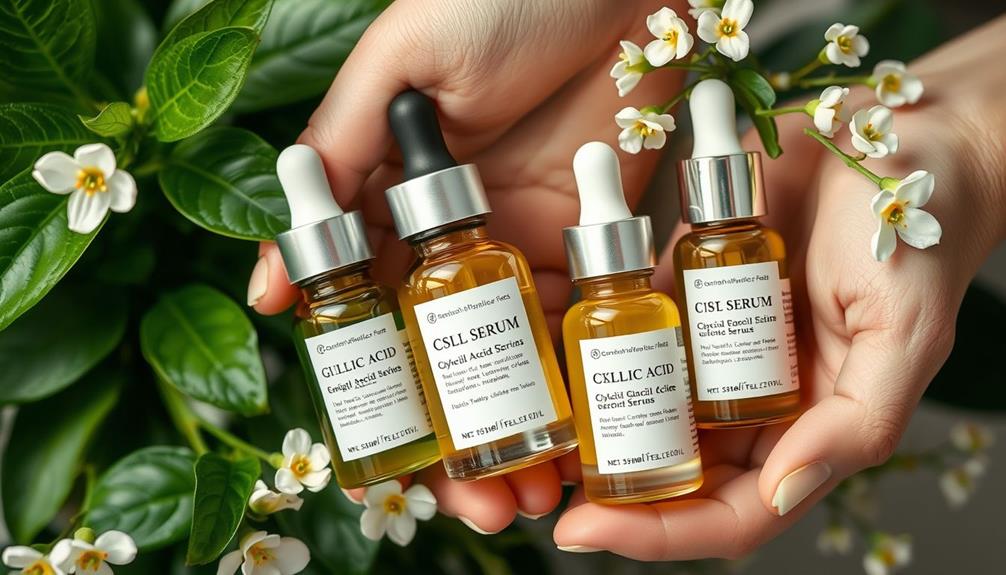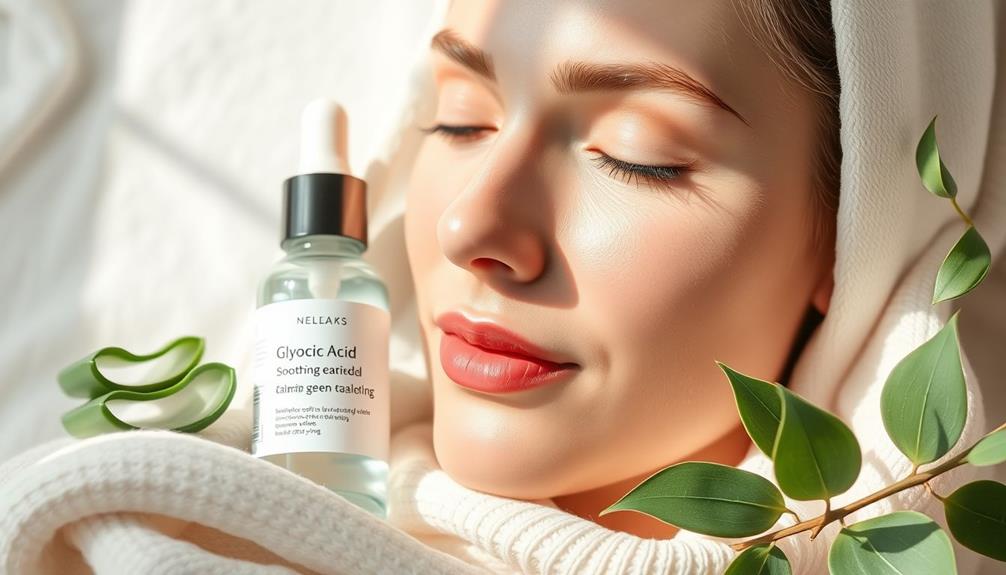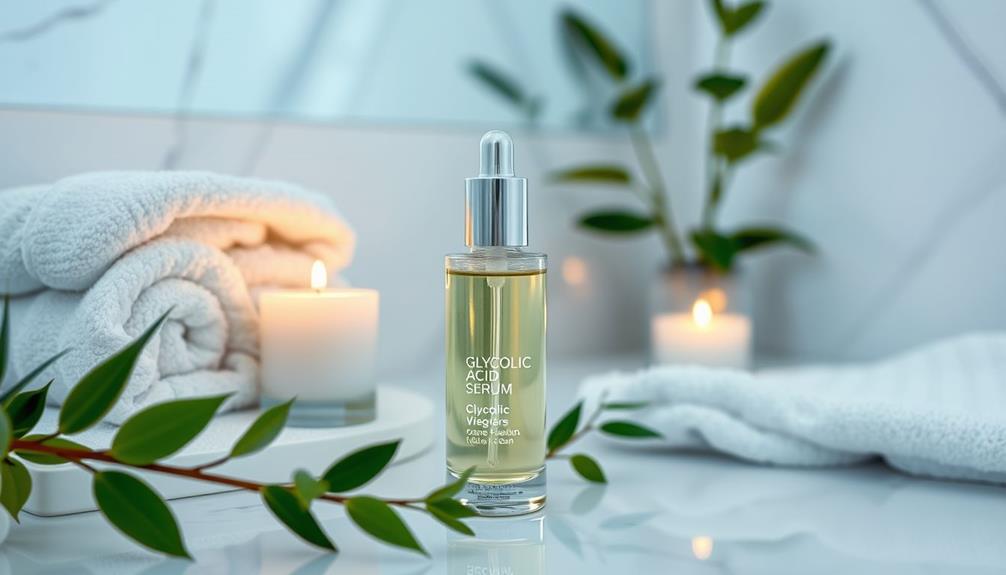Glycolic acid is your secret weapon for transforming your skin. This alpha-hydroxy acid speeds up skin cell turnover, giving you a smoother and brighter complexion. It tackles issues like hyperpigmentation, fine lines, and acne scars, making your skin look youthful and radiant. When you start using it, opt for lower concentrations and gradually increase as your skin adjusts. Remember to follow up with a hydrating moisturizer and always apply sunscreen, as glycolic acid can increase sensitivity to sun exposure. By incorporating glycolic acid correctly, you'll reveal a range of skin benefits that are just waiting to be uncovered.
Key Takeaways
- Glycolic acid exfoliates dead skin cells, promoting smoother texture and brighter complexion through increased skin cell turnover.
- It effectively reduces hyperpigmentation and fine lines, enhancing overall skin tone and reducing acne scars.
- Regular use boosts collagen production, improving skin elasticity and hydration for a youthful appearance.
- Begin with lower concentrations to gauge skin sensitivity, gradually increasing frequency for optimal results.
Understanding Glycolic Acid

Glycolic acid, a potent alpha-hydroxy acid derived from sugarcane, penetrates deeply to effectively exfoliate and renew your skin. Its small molecular size allows it to dissolve the bonds between dead skin cells, promoting skin renewal and enhancing cell turnover.
When you use glycolic acid, you're not just exfoliating; you're also improving your skin's texture and tone. Additionally, incorporating natural ingredients such as essential oils for skin care can complement the effects of glycolic acid, offering hydration and nourishment to your skin.
Typically available in concentrations ranging from 5% to 30%, glycolic acid can be tailored to suit your skin type and concerns. Whether you're a beginner or more experienced, you can find the right strength for you.
Regular use of glycolic acid can lead to significant benefits, including reduced hyperpigmentation and increased collagen production. This increase in collagen helps your skin maintain its elasticity and firmness, resulting in a clearer, more radiant complexion.
As you incorporate glycolic acid into your skincare routine, remember to use sunscreen during the day. It's essential since glycolic acid can increase your skin's sensitivity to UV rays.
Benefits for Skin Health

When you incorporate glycolic acid into your skincare routine, you'll notice significant benefits for your skin health.
It effectively exfoliates and renews your skin, helping to reduce hyperpigmentation and promote a more even tone.
Additionally, adopting a diet rich in nutrient-dense foods can further support skin health and enhance the effects of your skincare products.
With regular use, you can achieve smoother texture and a brighter complexion.
Exfoliation and Renewal
Exfoliating with glycolic acid reveals smoother, clearer skin by effectively dissolving the bonds between dead skin cells. This powerful alpha-hydroxy acid promotes skin renewal, allowing your complexion to thrive. Regular use not only enhances cell turnover but also boosts collagen production, giving you a firmer appearance.
Here's how glycolic acid benefits your skin:
| Benefit | Description | Result |
|---|---|---|
| Exfoliation | Dissolves dead skin cells | Smoother texture |
| Skin Renewal | Promotes cellular turnover | Fresh, youthful glow |
| Deep Penetration | Small molecular size reaches deeper layers | Enhanced elasticity |
| Acne Prevention | Unclogs pores | Clearer skin |
| Hydration | Attracts moisture to the skin | Plumper, hydrated look |
When you incorporate glycolic acid into your routine, you're not just exfoliating; you're also addressing fine lines and encouraging a radiant complexion. Its humectant properties guarantee your skin stays hydrated while reaping the rewards of effective exfoliation and renewal. Embrace the transformation glycolic acid can bring to your skincare regimen!
Hyperpigmentation Reduction
Reducing hyperpigmentation is essential for achieving a more even skin tone, and glycolic acid plays an important role in this process by effectively sloughing off dead skin cells and diminishing excess melanin.
When you incorporate glycolic acid into your skincare routine, you promote faster skin cell turnover, which helps fade dark spots and hyperpigmented areas more efficiently than conventional treatments.
Additionally, using essential oils like lavender can complement your skincare efforts, as they're known for their skin health benefits and calming properties, making them a great addition to your routine aromatherapy benefits.
Using glycolic acid 1-2 times a week can considerably reduce hyperpigmentation caused by UV exposure and acne scarring. If you have sensitive skin, don't worry—lower concentrations of 5-10% glycolic acid are still effective and gentle enough for your needs.
As you address hyperpigmentation, you'll also notice an improvement in your overall skin texture. Glycolic acid not only targets dark spots but also refines your complexion, leaving it smoother and healthier-looking.
The combination of these benefits makes glycolic acid a powerful ally in your quest for radiant skin. So, if you're looking to even out your skin tone and enhance your skin texture, adding glycolic acid to your regimen is a smart choice.
Choosing the Right Concentration

When choosing the right concentration of glycolic acid, you need to take into account your skin sensitivity and experience level.
Starting with a light concentration can help you gauge how your skin reacts before moving to stronger formulations.
Gradually adjusting the concentration allows your skin to adapt without risking irritation.
Understanding Concentration Levels
Choosing the right concentration of glycolic acid is essential for achieving your desired skin results while minimizing irritation. Glycolic acid concentrations typically range from 5% to 30%.
If you're just starting or have sensitive skin, it's best to begin with lower concentrations, around 5% to 10%. These levels help enhance skin elasticity and luminosity without causing excessive irritation.
Once your skin adjusts, you can gradually move to moderate concentrations (10% to 20%). These are perfect if you're looking to improve your skin texture and tone without significant peeling.
If you're an experienced user targeting specific concerns like deep wrinkles or pronounced hyperpigmentation, you might consider higher concentrations (20% to 30%).
However, always remember that your concentration choice should align with your skin concerns. Lower concentrations are great for gentle care, while higher percentages can effectively combat spots and imperfections.
Adjusting for Skin Sensitivity
To guarantee your skin responds well to glycolic acid, it's important to adjust the concentration based on your skin's sensitivity. If you're a beginner or have sensitive skin, start with glycolic acid concentrations below 4%. This lower concentration allows your skin to acclimate without causing irritation. Once you're comfortable, you can gradually introduce higher concentrations.
For those with normal to combination skin, moderate concentrations between 4%-8% can enhance skin texture and tone. If you're more experienced and targeting significant skin concerns or signs of aging, you might consider intense concentrations of 8%-10%. However, keep a close eye on your skin for any signs of irritation.
A gradual introduction is key. Try using glycolic acid just 1-2 times a week at first, then increase frequency as your skin builds tolerance.
Incorporating Into Your Routine

Incorporating glycolic acid into your skincare routine can enhance your complexion while promoting a smoother, more radiant appearance.
Start with glycolic acid products that contain a low concentration of around 5%. This approach minimizes irritation, especially if you have sensitive skin. Gradually increase the concentration to 10% as your skin builds tolerance.
Apply these products to clean, dry skin in the evening. This timing boosts their effectiveness and reduces the risk of UV sensitivity during the day. Initially, limit usage to 1-3 times per week. Adjust the frequency based on how your skin responds, as over-exfoliation can lead to irritation.
After applying glycolic acid, always follow up with a hydrating moisturizer. This step supports your skin barrier and helps mitigate any dryness or peeling effects.
Additionally, don't forget to incorporate broad-spectrum sunscreen with at least SPF 30 into your daytime routine. Since glycolic acid can increase your skin's sensitivity to sunlight, protecting your skin from UV rays is essential.
Safe Ingredient Combinations

When you're using glycolic acid, it's essential to know which ingredients work well together.
Pairing it with hydrating ingredients like hyaluronic acid or soothing options like aloe vera can enhance its benefits while minimizing irritation.
On the other hand, you'll want to avoid mixing it with retinol to prevent excessive sensitivity.
Effective Pairing Options
Pairing glycolic acid with complementary ingredients can enhance your skincare routine by maximizing benefits while minimizing irritation.
One effective combination is glycolic acid with hyaluronic acid. This duo boosts hydration, helping to prevent the dryness that can sometimes result from exfoliation.
If you're looking to soothe your skin, try combining glycolic acid with niacinamide. This pairing not only improves texture but also reduces redness, making your skin look more even.
Another great option is using glycolic acid alongside ceramides. This combination supports your skin barrier, which is essential for minimizing irritation while retaining moisture.
For those seeking gentle exfoliation, consider lactic acid. When used with glycolic acid, this duo provides a synergistic effect, enhancing skin smoothness without causing excessive irritation.
Just remember, it's best to avoid using glycolic acid with retinol or other strong acids simultaneously, as this mix can lead to increased irritation and sensitivity.
Avoiding Irritation Risks
To keep your skin healthy while using glycolic acid, it's important to understand which combinations can lead to irritation and how to avoid them. Here are some key tips to help you navigate your skincare routine and minimize skin sensitivity:
- Avoid combining glycolic acid with other exfoliants like salicylic acid or lactic acid. This can lead to over-exfoliation and increased irritation.
- Don't mix glycolic acid with retinol or other vitamin A derivatives. These ingredients can heighten skin sensitivity, so it's better to use them on alternate days.
- Pair glycolic acid with hydrating ingredients such as hyaluronic acid or ceramides. This combination can help mitigate dryness and irritation while boosting hydration.
- Separate your vitamin C and glycolic acid applications. Using them together can lead to irritation; instead, apply vitamin C in the morning and glycolic acid at night.
Application Techniques

Properly applying glycolic acid on cleansed skin enhances absorption and effectiveness, making it vital to establish a consistent nighttime routine. Start with a lower concentration, around 5%, to minimize irritation and build tolerance. Aim to use glycolic acid 1-3 times per week initially, gradually increasing as your skin adapts.
Here's a quick reference table for effective application techniques:
| Step | Description |
|---|---|
| 1. Cleanse | Wash your face thoroughly with a gentle cleanser. |
| 2. Apply glycolic acid | Use a pH-balanced product to guarantee gentler exfoliation. |
| 3. Moisturize | Follow up with a hydrating moisturizer containing ceramides. |
| 4. Protect | Always apply broad-spectrum sunscreen during the day. |
Incorporate these application techniques into your skincare routine to maximize the benefits of glycolic acid. Remember, consistency is key, and protecting your skin from UV exposure is essential, especially after using glycolic acid. Your skin deserves the best care for best results!
Managing Side Effects

Managing side effects from glycolic acid involves understanding your skin's tolerance and adjusting your routine accordingly. To effectively minimize irritation and manage skin sensitivity, follow these steps:
- Start Slow: Begin with lower concentrations (5-10%) and limit use to 1-3 times per week. Gradually increase frequency as your skin adjusts.
- Patch Test: Always conduct a patch test before full application. This helps you monitor any adverse reactions and gauge your skin's sensitivity.
- Moisturize: After applying glycolic acid, use a ceramide-rich moisturizer to combat dryness and support your skin barrier, which can reduce potential side effects.
- Sunscreen Essential: Since glycolic acid heightens skin sensitivity to UV rays, apply a broad-spectrum sunscreen with SPF 30 or higher daily to protect against sunburn and hyperpigmentation.
If you notice excessive redness, peeling, or irritation, cut back on application frequency or consult a dermatologist for tailored advice on managing side effects. With these strategies, you can enjoy the benefits of glycolic acid while keeping unwanted side effects at bay.
Professional Treatment Options

Professional treatments with glycolic acid offer a powerful way to achieve deeper exfoliation and faster results than typical over-the-counter products. When you opt for a professional treatment, you can expect higher concentrations of glycolic acid (20%-30%) that effectively address various skin concerns. Here's a quick overview of what you can expect:
| Treatment Type | Benefits | Frequency |
|---|---|---|
| Chemical Peels | Reduces acne & hyperpigmentation | Every 4-6 weeks |
| In-Office Treatments | Improves skin texture & tone | As recommended by dermatologist |
| Combination Treatments | Enhances results with antioxidants | Tailored to individual needs |
Research and Evidence

Numerous studies confirm that glycolic acid effectively treats acne and enhances skin texture, making it a go-to ingredient for many skincare professionals. This powerhouse ingredient not only addresses existing skin concerns but also promotes healthier skin overall. Here are some key findings from research:
- Acne Treatment: Clinical trials show significant reductions in acne lesions after using glycolic acid, proving its effectiveness in acne management.
- Skin Texture Improvement: Studies demonstrate that glycolic acid smooths skin texture, offering a refined appearance by promoting cell turnover.
- Collagen Production: Research indicates that glycolic acid stimulates collagen production, which enhances skin elasticity and helps reduce fine lines and wrinkles.
- Hyperpigmentation Reduction: Evidence suggests glycolic acid effectively diminishes hyperpigmentation from UV exposure by accelerating dead skin cell shedding.
With its versatile applications and proven benefits, glycolic acid stands out in the skincare industry. Peer-reviewed articles support its safety and efficacy across various skin types, making it a reliable choice for both over-the-counter and professional products.
You can trust glycolic acid to deliver noticeable results in your skincare routine.
Popular Glycolic Acid Products

If you're looking to incorporate glycolic acid into your skincare routine, there are several popular products that deliver effective results. One standout is SkinCeuticals Glycolic 10 Renew Overnight. This overnight cream features a 10% concentration of glycolic acid, promoting gentle exfoliation and skin renewal while you sleep.
For a more budget-friendly option, consider L'Oréal Paris Revitalift Triple Power 10% Pure Glycolic Acid Serum. This serum combines 10% glycolic acid with aloe juice to enhance skin texture and provide hydration.
Naturium Glycolic Acid Resurfacing Solution at 8% is another affordable choice, suitable for regular use on various skin types, offering both exfoliation and hydration.
If you're willing to spend a bit more, Drunk Elephant TLC Framboos Glycolic Night Serum combines glycolic and salicylic acids for thorough exfoliation and pore congestion treatment.
Finally, The Ordinary Glycolic Acid 7% Toning Solution is a fan favorite, known for its effective yet budget-friendly exfoliating properties, improving skin texture and clarity with consistent use.
Frequently Asked Questions
Do Dermatologists Recommend Glycolic Acid?
Yes, dermatologists recommend glycolic acid for its exfoliating properties and ability to improve skin texture. They often suggest starting with lower concentrations, gradually increasing use to avoid irritation while enhancing your skin's appearance and health.
What Does Glycolic Acid Do to Your Skin?
Imagine shedding old leaves in spring; glycolic acid helps you do just that for your skin. It exfoliates, boosts collagen, clears pores, and fades dark spots, revealing a fresher, more radiant complexion with regular use.
Is Glycolic Acid Good for Mature Skin?
Yes, glycolic acid's great for mature skin! It boosts collagen production, enhances cell turnover, and helps even out skin tone. Just start with lower concentrations to avoid irritation, and gradually increase as your skin adjusts.
Does Glycolic Acid Remove Dark Spots Permanently?
Glycolic acid doesn't remove dark spots permanently. It effectively fades them through exfoliation and enhanced cell turnover, but ongoing maintenance and sun protection are vital to prevent their return and maintain your skin's clarity.
Conclusion
Incorporating glycolic acid into your skincare routine can transform your skin, revealing a brighter, smoother complexion.
As you explore its benefits, you might notice how it coincides with your journey toward self-care, helping you embrace both inner and outer beauty.
Just remember to start slow and pay attention to your skin's needs.
With the right concentration and care, you'll access the dermatologist's secret and discover a newfound confidence that radiates from within.









